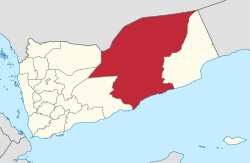Dammun, Yemen
| Dammun دمّون | |
|---|---|
| Village | |
 Location of Hadhramaut in South Yemen | |
 Dammun Dammun location in Yemen | |
| Coordinates: 16°04′14″N 49°00′42″E / 16.0705556°N 49.0116667°ECoordinates: 16°04′14″N 49°00′42″E / 16.0705556°N 49.0116667°E | |
| Country |
|
| Governorate | Hadramaut |
| Directorate | Sayun District |
| Area | |
| • Total | 7 km2 (3 sq mi) |
| Elevation[1] | 591 m (1,939 ft) |
| Population | |
| • Total | 1,788 |
| • Density | 260/km2 (660/sq mi) |
| Time zone | UTC+3 |
Dammun (Arabic: دمّون ) is a wadi (Valley) village in Hadramaut, Yemen, about 4.2 kilometres (2.6 mi) north east of Tarim. Dammun is known for its fertile agricultural land which is the gate and the front of the Wadi Douan, famous for the production of the finest types of Yemeni honey. The place is known in the region since ancient times as a haven for fugitives from tribal conflicts and feuds or wars for its stronghold on the hills and mountains.
The village is sparse as there is only a few houses built and some farms.[2] Dammun is also where al-Hajerin located up above a hill, where many historical monuments are located near the settlement of Ripon, which was built on the ruins of the city dating back to pre-Islam, and where there is a temple called Sen or else known as the temple of the moon.[3] In this location there is history of sixth-century poet-prince Imru al-Qays banished by his father for excessive drunkenness and fornication. Imru al-Qays was later known as al-Malik al-Dillil (the Wandering King) and posthumously as Dhul al-Quruh (He of Sores).
The huntsmen of Dammun is known to hunt with nets and fireams.[4] Dammun, though once well known for its wine presses, has, since the coming of Islam, produced many great Sufi saints as well as traditional scholars and poets. One of these was al-Mu’allim ’Abd al-Haq al-Dammuni (d. 1872), whose compositions in verse have been used extensively by some modern scholars (Muhammad ‘Abd al-Qadir Ba-Matraf, for example) as source material for history covering the Kathiri-Yafi’i wars during the latter part of the nineteenth century. Indeed, while al-Jahiz (d. 869) was to state that poetry amongst the Arabs was used ‘to immortalize events’, al-Jumahi (d. 917) maintained that ‘verse in the Days of Ignorance was to the Arabs the diwan (register) of all they knew’.
References
- ↑ "Elevation of Dammun, Yemen". Retrieved July 11, 2014.
- ↑ Samar Damlūji, Salmá (Aug 20, 2010). The valley of mud brick architecture: Shibām, Tarīm & Wādī Ḥaḍramūt : ancient to contemporary design. Garnet Pub. ISBN 978-1873938010.
- ↑ Mackintosh-Smith, Tim (2014). Yemen: The Unknown Arabia. Penguin. ISBN 978-1-468309980.
- ↑ Bidwell, R. L.; Rex Smith, G.; Smart, J. R., eds. (1994). New Arabian Studies. 2 (illustrated ed.). University of Exeter Press. ISBN 9780859894524.